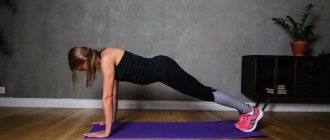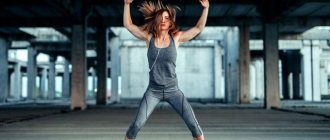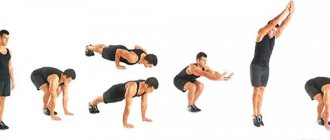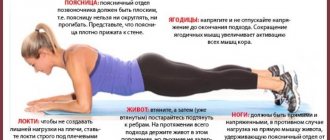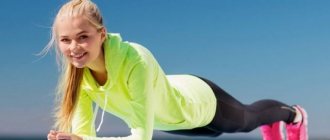The “reverse plank” is an exercise that enjoys special respect among beginners and professional athletes. With its help you can strengthen the muscle corset and increase muscle tone. Despite the fact that such a fixed position is not as popular as the classic plank, its effectiveness is amazing in the very first days of execution.
The article will tell you in detail what the “Reverse Plank” exercise is, the benefits and harms of it, and will also reveal reviews from people who have already tried this pose and got stunning results. This type of plank has a lot of advantages, so beginners in the sport who want to relieve back pain and strengthen their chest muscles should definitely pay attention to it.
The “Reverse Plank” exercise (photo also provided in the article) helps you keep yourself in great shape without increased vital activity. It can be performed without any additional equipment, so there is no need to visit a gym or purchase special equipment.
What muscles work in the “Reverse Plank” exercise?
During the exercise, the following muscles are worked:
- straight;
- pyramidal;
- oblique;
- lumbar;
- anterior and posterior muscles of the thighs;
- medial;
- calf;
- brachioradialis;
- triceps;
- shoulder;
- ulna.
From this list it is clear that the simplest exercise forces several muscle groups to work simultaneously. While in the pose, perhaps not all muscles will be felt, but the next day you can feel a pleasant pain in them.
Benefit
Due to the fact that all muscle groups are loaded, blood flow accelerates, organs and their systems are saturated with oxygen, and the overall tone of the body increases significantly. This is where the benefits of the “Reverse Plank” exercise come into play. If you do it regularly, you can achieve good success. Thanks to the exercise you can:
- reduce the thickness of the fat layer in one of the most problematic areas - the lower abdomen;
- strengthen the upper abs, muscles of the upper limbs;
- improve body flexibility;
- increase the tone of the spinal muscles;
- maintain correct posture.
In general, the “Reverse Plank” exercise makes it possible to get rid of excess weight, stop pathological changes that cause severe pain in the lumbar area, and also correct posture.
The benefits, harm and effectiveness of planks for weight loss
The benefits of doing planks
1. The plank is an ideal exercise for the abdominal muscles because it covers all major abdominal muscle groups, including the transverse, rectus, and oblique muscles.
2. The plank engages not only the core muscles, but also the muscles of the shoulders, chest, buttocks, upper back, front and back of the thigh. This is a unique exercise that will force your entire body to work.
3. Thanks to the bar, you will strengthen the muscle corset that supports your spine, which is an excellent prevention of back pain.
4. Using a plank, you will strengthen your back and buttocks without damaging the musculoskeletal system and joints (unlike, for example, deadlifts, squats and lunges).
5. Regular planking will help you maintain a straight posture and a straight back.
6. The plank exercise is available for everyone: from beginner to advanced. Simply adjust the time you hold the static position depending on your training.
7. By strengthening your core muscles, you can improve your balance and balance, which will be useful to you in everyday life.
8. Unlike many other abdominal exercises, the plank does not have a damaging effect on your lower back.
9. The plank has a large number of modifications: our article alone offers more than 40 options!
10. You can do the plank absolutely anywhere: at home, on the street, in the gym. You just need some free space.
Harm of the plank
However, despite all the benefits of the plank, this exercise can be fraught with danger. For example, if your core muscles are not strong enough, your spine will sag during planks, putting pressure on your spinal discs, lower back, and shoulder joints. With the slightest violation of the correct form of the exercise, you may feel pain in the neck or lower back.
In addition, prolonged planking can cause high blood pressure and even a heart attack, and people with hypertension are especially at risk. Therefore, you should not be in the plank for more than two minutes at a time. If you want to increase the load on the muscles, then it is better to go in the direction of complicating the plank variations (for example, with a raised arm or leg) than in the direction of increasing the time of the static position.
For people who are overweight, it is recommended to do the plank on your knees. This will help reduce stress on your back and joints. However, the plank is one of the safest exercises for core development. It is much less damaging to the spine than most other abdominal exercises that are performed on the back.
Typical mistakes when doing planks
In order to avoid problems with the spine from performing the plank incorrectly, we draw your attention to typical mistakes in this exercise:
- hunched back, shoulders down
- lifting the buttocks up, above head level
- arching or rounding in the lower back
- relaxation of the abdominal muscles, legs and buttocks
- lifting the head up and bending the cervical spine
- holding your breath
Is planking effective for weight loss?
The plank strengthens muscles, works the core, improves the tone of the hips, buttocks, arms and shoulders, but the plank is not an effective exercise for burning fat and losing weight. The plank does not help to remove the belly and get rid of the sides! This exercise is designed to tone muscles, not burn fat.
Moreover, we emphasize once again that the process of losing weight depends on nutrition, and not on exercise. Exercising helps burn more calories, tone muscles, improve body quality, but losing excess weight occurs only with food restrictions (calorie deficit). The plank and its modifications are a great way to strengthen the body, get rid of sagging and lack of exercise, but to lose weight, dietary restrictions are required.
If your goal is to lose weight, then it is better to focus on dynamic exercises, which help burn more calories than static exercises. Ideally, do regular cardio exercise. Moreover, cardio exercises can also be performed in the plank, thereby achieving two goals at once: burning calories and strengthening the abdominal muscles. Read more about plank cardio exercises below.
Contraindications
As you know, playing sports has certain restrictions. Trainings should be conducted taking into account your own physiological parameters, age characteristics and health status.
The “Reverse Plank” exercise is not recommended to be performed in the following cases:
- pregnancy period;
- previous injuries to the shoulder joints or elbows;
- hernia;
- compression fracture;
- C-section;
- various operations on the abdominal organs.
In addition to this list, you should also pay attention to relative contraindications. These include injuries to the wrists and hands. In this case, it is recommended to perform a simple modification of the Reverse Plank exercise. To do this, you will need to rely not on straight arms, but on your elbows, which will also effectively load the muscles of your abdomen, back and legs.
How to do the “Reverse Plank” exercise correctly
The position in question can be performed in various modifications. It can be both simplified and complicated. First of all, you need to take care of your comfort during the exercise so as not to get injured or slip. To do this, you need to lay a special rug or mat. Despite the fact that the likelihood of getting a fracture when falling from such a height is small, no one is immune from abrasions and hematomas. Therefore, it is necessary to perform the “Reverse Plank” carefully, concentrating only on it.
Classic version
Every beginner can do the classic exercise without any special training. It is done this way:
- Sit on a non-slip mat and extend your legs straight forward, bringing them together.
- Tilt your back 45 degrees, rest your hands on the floor so that your hands are clearly under your shoulders, and point your fingers towards your feet.
- Push your body up, distributing support on your arms and legs.
- Align your body in a straight line so that there are no bulges or bends.
- Hold the pose for 15 seconds, during which you should never relax your buttocks or abdomen.
- Smoothly lower yourself to the starting position, allowing yourself to relax only after your buttocks touch the floor surface.
It will not be difficult for experienced athletes to repeat a fixed pose immediately after the body has lowered itself onto the mat, because they have already mastered this exercise to the point of automatism. But beginners will need to take short breaks between approaches.
Number of approaches to achieve the greatest efficiency
For those who have just begun to engage in fitness and sports, it would not hurt to know that the load should be given gradually. Therefore, start raising your pelvis and keeping your torso in a straight position, for example, from 10 seconds.
At the same time, it is advisable to perform the exercise regularly - at least 3 times a week. Moreover, each time increase the holding time by several seconds. Everyone will orient themselves in this case on their own, as they will understand how much they can withstand this situation. Sometimes, if it is difficult to do this load, then you can keep the same time for several days and then increase the duration. This is especially true for those who have not loaded their body with physical activity for a long time, for example, women after childbirth are better off completing the bar by starting light exercise. During 1 workout you can perform 2 approaches.
It is important to consider your own condition. If your arms and legs are trembling, you should stop moving and give your body a rest. If it’s hard to stay in the plank, you can help yourself by interrupting your breathing.
Between the two approaches, you can relax the body muscles by shaking your limbs and light rotational movements. You can walk by raising your knees up.
Modifications on straight arms
Today, many different options for performing the exercise on straight arms have been invented. All of them contribute to the development of several muscle groups, but some are extremely difficult to perform. To find the most suitable option for yourself and achieve success with it, you need to familiarize yourself with the best positions:
- When turning your fingers towards the body, it is not the brachialis, but the biceps muscle that tenses.
- If you want to work your shoulder joints, then your hands should be positioned as far away from the body as possible during the exercise.
- To increase the stretch of the hip and gluteal muscles, you need to perform a plank with hip raises. To do this, you need to follow the technique described above, but keep your legs not straightened, but bent at a right angle.
- You can make the exercises more difficult to quickly eliminate fat deposits by swinging your legs alternately while at the top point.
- Rotation of the pelvis at a fixed point will provide an excellent opportunity to work out the oblique muscles.
Varieties of back plank
The reverse plank on straight arms has many different variations, thanks to which you can shift the load. Any change in the starting position will help redistribute the load. Options for the back plank may be as follows:
- The simplest option for changing the starting position is to turn your hands with your fingers towards you before lifting your body. Thus, the load from the brachialis muscle will shift to the biceps muscle.
- If you want to properly work out your shoulder joints, then when performing the exercise, try to place your hands as far away from the body as possible . Increase this distance gradually, focusing on the nagging pain in the shoulder area. When you stretch the ligaments of the joints so that there are no unpleasant sensations in the shoulders, you will be able to move your hands further.
- To improve stretching of the gluteal and thigh muscles, you can resort to reverse plank hip raises. In this case, you need to rise from the following starting position - sit on the floor, lean your body back 35-45 degrees, lean on your hands, turn your fingers towards you, bend your knees. Let your feet rest completely on the floor. Climb into the half-bridge without bending your body. Once you have mastered this position, you can modify it slightly by placing your hands closer to your body and straightening your legs completely. In the final position, the body should be slightly bent.
- A rather difficult version of the reverse plank, which increases the load on the supporting limbs, effectively works the thigh muscles and improves stretching. The starting position is the same as for the classic back plank. Perform forward swings while already in a fixed position or at the same time as rising into it. When the swing leg is bent, it is easier to maintain balance; if it is straight, it is more difficult. It is most difficult to perform this exercise when the leg rises very slowly and falls just as slowly.
- This variation of the reverse plank helps to work out problematic inner and outer thighs. When performing the exercise, first fix the position at the highest point, and then move your legs to the sides. The simplest option: rise to the reverse plank, perform three swings with one leg, lower, rest a little, rise again and do similar swings with the other leg.
- You can increase the load on the oblique abdominal muscles by performing crunches. Without changing your body position, rotate your pelvis in a fixed position.
- You can complicate the exercise by lifting and alternately stretching your arms, simultaneous swings of your legs and arms, both on the same side and opposite.
The reverse plank can also sometimes be performed with weights.
Usually, for this, a dumbbell is taken in one hand. Having risen to the plank position, you must pull the weight towards the pile with your arm bent at the elbow. There are other options for the reverse plank. So, to stretch the muscles of the legs, you can, in a fixed position, rest on your heels and move your feet, stretching your toes. To effectively work out the abs, you can combine the main pose with bodyflex - deep belly breathing.
Rules for performing the exercise
Remembering the basic rules and following them is not so difficult, so you should not ignore them:
- You need to immediately tune in to the maximum load on your hands. People who want to master the plank should not have any problems with their hands. Otherwise, you can become the owner of a subluxation or even dislocation of the wrist joint. Also, do not forget that when performing the exercise on the elbows, it will not be possible to create a chic relief of the forearms.
- It is best to do a plank immediately after training. At this time, the muscles have not yet cooled down, so they can be properly stretched without getting a tear or sprain.
- At the top point, you need to carefully monitor the position of the body. The body and legs must form a straight line. The only exception is the maximum hip lift exercise, but it is not recommended for beginners.
- In the first couple of days, the classic plank should be done for no more than 15 seconds. You can make the task easier by pulling in your stomach and taking breaks in breathing. It is allowed to increase the time spent in the pose only after you can breathe through the chest automatically.
- If your legs begin to tremble, then you should stop doing the plank and give your body a rest. This rest should be active so that the muscles remain warm all the time. The ideal option is to walk calmly, raise straight and bent legs, bend in different directions, and so on.
Newbie mistakes
Most often, those who do not perform the side plank correctly cannot stay in the pose. Let's look at the most common mistakes made by novice athletes, which also happen to professionals:
- Bent, hunched back. In this position, it is difficult to maintain balance, your back quickly begins to hurt and it is difficult to breathe.
- Incorrect hand position. If the hand is placed at a different angle than necessary, there will be a risk of injury to the joints of the hand, the inability to perform the exercise, and improper load on the body.
- Sagging of the pelvis during fixation. If the buttocks are not tense, the movement will not be possible, since these muscles are the main ones for performing the plank.
- Head down. A chin lowered toward the chest makes breathing difficult and creates unnecessary stress on the neck muscles.
- Relaxed or bent knees. Due to this position of the legs, proper execution of the exercise will be impossible.
Reviews
Many people leave their reviews about the Reverse Plank exercise, which allows beginners to see the effectiveness and efficiency of this pose. Girls who have been trying to fight excess weight for a long time, but this is difficult, are especially enthusiastic about the exercise. This type of plank helped them lose about 5 kilograms in just a month. At the same time, the excess volume in the lower abdomen also disappeared. The girls themselves claim that they did not perform any additional exercises. In order to achieve such a great result, it was enough for them to limit themselves in the consumption of sweets and flour products, as well as doing the plank twice a day.
There are often reviews from people who do the exercise to strengthen their muscles, and they succeed very well. For athletes training at home, the “Reverse Plank” helped strengthen the corset without any additional equipment. Thanks to this, they were able to save time and money on visits to gyms.
Why is it worth doing a plank?
The straight plank is at the peak of popularity today. It is performed by beginners who have crossed the threshold of a fitness establishment for the first time, and by advanced fitnessists with pumped up muscles and a toned body. The plank uses many muscles at the same time and at the same time gives quick results. This is its main difference from many other bodyweight exercises.
Interestingly, only those people who have sufficiently strong core, hip, back and arm muscles can stand in the plank. Otherwise, a person cannot last even a minute. There are even special tests on the Internet that determine the level of training of an athlete by the amount of time spent in the plank position.
But all this is relevant in relation to the classic exercise - the straight plank. And there is also such a variety as the reverse. It is more difficult and requires more effort and skill. But it also gives you more bonuses! So what do you get if you wait for the “starting” 30 seconds?

